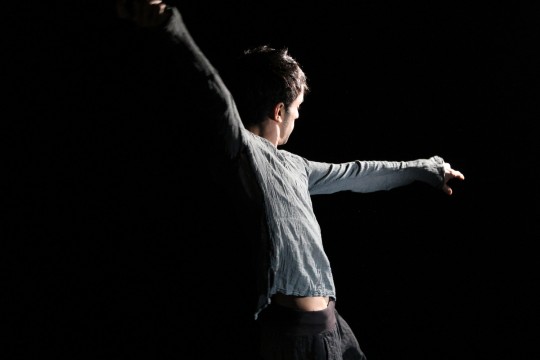
“Rising” by Aakash Odredra made its US debut at the Wexner Center for the Arts from Oct. 23-26. Credit: Chris Nash
Through a soft haze from the fog machines, Aakash Odedra was slowly illuminated in a confined black room.
The solo dancer sprung into life, at times punctuating the air with his arms — at others, swimming through it.
This dance, “Nritta,” was the first of four on Friday night by Odedra, a British dancer and choreographer specializing in Kathak and Bharat Natyam, two styles of Indian dance.
These four performances, collectively titled “Rising,” premiered in 2011 as the inaugural work of Odedra’s recently founded production company.
Since then, he has choreographed works for Queen Elizabeth’s Diamond Jubilee and has performed solo shows at venues as diverse as London’s Royal Opera House and New York’s Apollo Theatre.
With that sort of resume, it was a thrill to see “Rising” making its U.S. premiere in such an intimate performance at the Wexner Center for the Arts.
In this Black Box on Mershon Auditorium’s stage — which seats only a few dozen — this intimacy gave the feeling that this was a private court performance and we were all monarchs on our respective thrones.
Odedra’s performance was excellent in every way. He was a meticulous master of movement — able to dazzle with the technique and mesmerize with a mystic expressiveness.
In the first piece, he was spectacular in his ability to mirror the accompaniment of drums and sitar, moving his arms with the flow of the sitar and separately slapping his feet to the floor in time with the drums.
As the musical became more frenetic, Odedra followed suit, as though each pluck of the strings whirled him and flung his limbs through the void like a marionette.
It was a technical exhibition from a virtuoso.
In the next three performances, however, his body was not the subject, it was just a tool to express the themes of each piece.
In his artist’s statement for “In the Shadow of Man,” Odedra wrote that this piece aims to explore his “continuous fascination with the ‘animal’ we have within ourselves.”
That statement was superfluous in conveying the intent to the audience. When he rose up under a pale red spotlight, Odedra morphed into something subhuman so easily. He was remarkable not for his ability to evoke something animalistic, but to transform himself into a new life-form so convincing his movements could strike up a fear that this was a dangerous animal before us, on the cusp of attack at any moment.
He moved as though he had the soul of a beast fighting to get out. He shed every shred of human poise, now a grotesque and graceless monster. Ugly and reactionary. He writhed on the ground like a primitive body of demonic possession.
His penultimate performance, “CUT,” was like a narrative of discovery. He stood center stage as a thin curtain of light shone down before him. His hands penetrated the wall with childlike curiosity. He caressed the light for information, intermittently pulling back with a timid distrust of this new force.
Gradually, he immersed more of himself into the glow, cutting in and out, bathing in the warmth. As the indulgence of the dance progressed, more curtains of light opened up to Odedra. He took the invitation, spinning something celebratory through these perforations.
The final performance, “Constellation,” saw Odedra wander around the stage, grasping orbs as they began to irradiate a golden glow. These light bulbs on cable were the most elaborate prop of the performance, and their simplicity was used to great effect. Odedra strolled among these hovering lights, manually swinging them into life like a shepherd of the cosmos. Each orb danced through the air and Odedra partnered with them. At a point, each light began to dim, like a great star dying slow.
As the lights faded, Odedra’s dance became more expressive, like a eulogy for the waning wonder. It was a solemn and desperate last act to repay the unreimbursable. Finally, he promenaded around the stage, extinguishing each light like a parent laying their child down sympathetically into a grave.
He grabbed a final orb and sat cross-legged on the ground with his prize in his lap. His dance was a prayer, but his behavior like an addiction, unwilling to let go.
Finally, with his last orb in front of him, his hands trembled violently around it, his sorcery causing all the dead orbs to flicker in and out of life — one man’s last attempt to reanimate the universe from its mortality.
And it was Odedra’s goodbye in a wonderful night of dance that showed how the human body can tell stories that resonate to the deepest levels.


